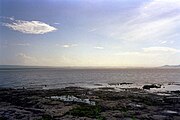Lake Managua
| Lake Managua | |
|---|---|
| Coordinates | 12°20′N 86°25′W / 12.333°N 86.417°W |
| Basin countries | Nicaragua |
| Max. length | 65 km |
| Max. width | 25 km |
| Surface area | 1,024 km² |
| Average depth | 9.5 m |
| Max. depth | 20 m |
| Surface elevation | 39 m |
| Settlements | Managua |
Lake Managua (Spanish pronunciation: [maˈnaɣwa]) (also known as Lake Xolotlán) (located at 12°20′N 86°25′W / 12.333°N 86.417°W) is a lake in Nicaragua. The Spanish name is Lago de Managua or Lago Xolotlán. At 1,042 km², it is approximately 65 kilometres (40 mi) long and 25 kilometres (16 mi) wide. Similarly to the name of Lake Nicaragua, its name was coined by the Spanish conquerors from "Mangue" (their name for the Mánkeme tribes) and agua ("water"). The city of Managua, the capital of Nicaragua, lies on its southwestern shore.
The lake has been severely polluted, mostly by decades of sewage being dumped into the lake.[1] The lake today has stable no outlet, with only occasional floods to Lake Nicarague through Rio Tipitapa. Pollutants are thus concentrated.[2] Despite the pollution, some of the people of Managua still live along the lake's shores and eat the fish.
It rose 3 metres (10 ft) in five days during Hurricane Mitch in 1998, destroying the homes of many who lived on its edge.
While joined to Lake Nicaragua the Bull sharks of that lake cannot migrate to Lake Managua due to a 12 foot high waterfall on the Tipitapa River.[3]
In 2007 the "malecón" area was dredged and the sediment hauled off on barges. A strong odor which permeated the area from the sediment disappeared. A stone rip-rap and concrete wharf was constructed and a sight seeing boat called "La Novia de Xolotlán" makes hour-long lake tours when there are sufficient tourists.
References
- ^ Hazel Plunkett. Nicaragua: A Guide to the People, Politics and Culture. Interlink Books, Dec 1, 2001. pg. 71
- ^ Thorson, Thomas B., "The Status of the Lake Nicaragua Shark: An Updated Appraisal" (1976). Investigations of the Ichthyofauna of Nicaraguan Lakes.Paper 41.
- ^ Thorson, Thomas B., "The Status of the Lake Nicaragua Shark: An Updated Appraisal" (1976). Investigations of the Ichthyofauna of Nicaraguan Lakes.Paper 41.



